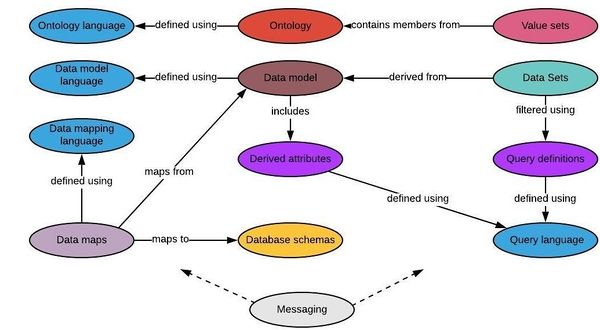Discovery health information model
The Discovery common information model consists of a set of components that are integrated as a whole to create something that is bigger than the sum of the parts.
The model has a much broader definition than simply a data model. It involves the modelling of the way in which data is converted to information.
A model is a representation of something real. Information is derived from an arrangement of data for particular purposes. An information model is a model of information.
More specifically, in this context, the information model is tailored to illustrate arrangements of health and care data as held in health records for the purposes of understanding and query as described by the objectives of the information model.
Information model component types
The model involves a close collaboration between different types of components, the collaboration occurring as a result of a common language which is both human readable (albeit quite technical) and machine readable. The components work together, so that the generation of output or the query of content, usually uses several components.
This diagram illustrates the main types of components of the model:
- The ontology language is the machine and human readable set of instructions as to what things mean and how they are classified. See the language as instructions to populate a model.
- The ontology is the set of concepts used in all parts of the information model, from clinical concepts through to data structure concepts
- A data model language is a simple set of classes used to define a logical data model.
- The data model is a set of entities, attributes and value sets, all of which are defined precisely in the ontology, but he data model, being created for a specific business of healthcare is separate to the ontology.
- Value sets are business purposes specific collections of concepts from the ontology used in the data model or in query and contain concepts as defined in the ontology, using the ontology language, including advanced concept classes.
- Data set definitions apply rules and filters to a data model in order to specify the nature of the entries and their content required in a purpose specific data set
- Data model maps specify how data is transformed from a data model to a particular database.
- Data base schemas are reference schemas (RDB and maps) showing an implementation of a data model and data sets. Strictly speaking these are not part of the information model but are included as “proof of solution” of the model.
- Derived attributes are data model attributes defined using the query language.
- Query definitions are a library of re-usable queries.
